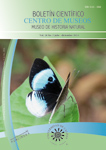Authors
Abstract
Due to the destruction and fragmentation of pristine habitats, urban sprawl and lack of basic information, it is necessary to research on community ecology of birds. Urban arboreal areas represent permanent arboreal habitats that support,and maintain conservation of local and continental avifauna. The studies on Nearctic migratory birds in Colombia are focused on the determination of richness but there is a lack on ecological details about their migration dynamics. The objective of this study was to determine ecological aspects of Neartic birds in an urban habitat such as arrival and departure dates, abundance, sex ratio, variation in fat deposits and interactions with residents. Between September 2011 and May 2012, bird watching and capture tours were carried out using mist nets on the Universidad del Valle campus at 990 meters above sea level. The first and last entries were done on September 20, 2011 and May 5, 2012, respectively. A total of 13 migratory bird species were recorded from which Setophaga petechia and Piranga rubra displayed the highest relative importance index (IIR = 2.386 and1.136, respectively). Differences in sex and species patterns were observed on the arrival and departure toward wintering areas. No correlation was found between weight and length of stay of birds, and the variation of energy reserves through the season is described. The study demonstrates importance of the arboreal sites, within urban areas, as temporary harbor for migratory birds.
References
ANGARITA,I.,2002. Composición y estructura de la avifauna de la ciudad de Cali: Tesis de grado, Universidad del Valle, Cali.
BAYLY, N.J., GÓMEZ, C.&CÁRDENAS,L.C., 2011. Darién, Monitoreo de la migración durante el 2011 en la Reserva Natural de la Sociedad Civil Tacarcuna. Proyecto ando el Caribe. SELVA: Investigación para la conservación en el Neotrópico, Bogotá. InformeTécnico No.CEC06.
BERTHOLD, P., 1996. Control of bird migration.Springer.
CRUZ-BERNATE, L., ARDILA-TÉLLEZ, J.D. &CAICEDO-ARGÜELLES, A.P.,2013. Monitoreo y morfometría de la avifauna del campus de la Universidad del Valle 2011-2012. Biota Colombiana, 15 (1): 126-132. Recuperado de http://ipt.sibcolombia.net/valle/resource.do?r=avifauna_migratoria
DEL HOYO, J., ELLIOT, A. &CHRISTIE, D.A., 2010. Handbook of the birds of the world. Vol. 15. Weavers to New World Warblers. Lynx Editions, Barcelona.
ESPINAL, S., 1968. Visión ecológica del departamento del Valle del Cauca. Universidad del Valle, Corporación Autónoma Regional del Valle (CVC) y Ministerio de Agricultura. Cali, Colombia.
FRANCIS, C.M. &COOKE, F.,1986. Differential timing of spring migration in wood warblers (Parulinae). Auk, 103:548-556.
FINCH, D.M., 1991. Population ecology, habitat requirements, and conservation of neotropical migratory birds. USDA Forest Service, Rocky Mountain Forest and Range Experiment Station. General Technical Report 205.
FUNDACIÓN PROAVES, 2009. Plan para la conservación de las aves migratorias en Colombia. Conservación Colombiana, 11: 1-154.
GOCHFELD, M., 1985. Numerical Relationships between Migrant and Resident Bird Species in Jamaican Woodlands. Ornithological Monographs, Neotropical Ornithology, 36: 654-662.
GÓMEZ, C., BAYLY, N.J., GONZÁLEZ, A.M., ABRIL, E., ARANGO, C., GIRALDO, J.I., SÁNCHEZ-CLAVIJO, L.M., BOTERO, J.E., CÁRDENAS, L., ESPINOSA, R., HOBSON, K., JAHN, A.E., JOHNSTON, R., LEVEY, D., MONROY, A., ANDNARANJO, L.G., 2010. Avances en la investigación sobre aves migratorias neárticasneotropicales en Colombia y retos para el futuro: trabajos del III Congreso de Ornitología Colombiana. Revista Ornitología Colombiana, 11: 3-13.
GÓMEZ, C. & BAYLY, N.J., 2011. La migración de aves en la Reserva El Dorado, Sierra Nevada de Santa Marta, Colombia. Proyecto Cruzando el Caribe: Identificación de sitios de parada críticos para aves migratorias Neotropicales en el norte de Colombia. SELVA: Investigación para la Conservación en el Neotrópico, Bogotá. Informe técnico No. CEC05.
HEDENSTRÖM, A., 2010. Extreme Endurance Migration: What Is the Limit to Non-Stop Flight? PLoSBiol., 8(5): e1000362.
HILTY, S.L. & BROWN, W.L., 2001. Guía de las aves de Colombia.SAO, Universidad del Valle y American Bird Conservancy -ABC-. Colombia.
JOSENS, M.L., FAVERO, M. & ESCALANTE, A.H., 2012. Diversity, seasonality and structure of birds assemblages associated with three wetlands in the southeastern Pampas, Argentina. Ardeola, 59(1): 93-109.
LIKOFF, L.E., 1986. The Encyclopedia of birds, Volume 1.Infobase Publishing, New York.
MACGREGOR-FORS, I. & ORTEGA-ÁLVAREZ, R., 2013. Ecología urbana: experiencias en América Latina. Instituto de Ecología, A. C.
MORENO, M.I., 2009. Aves migratorias en Colombia. Revista Conservación Colombiana, 11: 9-26.
MUÑOZ, M.C., FIERRO-CALDERÓN, K. & RIVERA-GUTIERREZ, H.F., 2007. Las aves del Campus de la Universidad del Valle, una isla verde urbana en Cali, Colombia. Ornitología Colombiana, 5(5): 5-20.
NARANJO, L.G., AMAYA, J.D., EUSSE-GONZÁLEZ, D. & CIFUENTES-SARMIENTO, Y., 2012. Guía de las Especies Migratorias de la Biodiversidad en Colombia. Aves. Vol. 1.Ministerio de Ambiente y Desarrollo Sostenible/WWF Colombia. Bogotá, Colombia.
OTAHAL, C.D., 1995. Sexual Differences in Wilson’s Warbler Migration. Journal of Field Ornithology, 66(1): 60-69.
OCAMPO-PEÑUELA, N., 2010. El fenómeno de la migración en aves: una mirada desde la Orinoquia. Orinoquia, 14 (2): 188-200.
OREJUELA, J.E.,RAITT, R.J. & ÁLVAREZ-LÓPEZ, H.,1980. Differential use by North American migrants of three types of Colombian forest:253-264 (en) KEAST, A. & MORTON, E.S. (ed.). Migrant Birds in the Neotropics: Ecology, Behavior, Distribution, and Conservation. Smithsonian Institution Press, Washington.
ORTEGA-ÁLVAREZ, R., MACGREGOR-FORS, I., 2011. Dusting off the file: A review of knowledge on urban ornithology in Latin America.Landscape and Urban Planning, 101: 1-10.
RAPPOLE, J.H. &MCDONALD, M.V., 1994. Cause and effect in populations declines of migratory birds. Auk, 111:652-660.
RAPPOLE,J.H., 1995. The ecology migrant birds. A Neotropical perspective Smithsonian Institution Press, Washington.
REYES-GUTIERREZ,M., SEDANO, R. & DURÁN, S., 2002. Lista anotada de la avifauna de la Universidad del Valle, Cali, Colombia. Boletín SAO, 13: 12-25.
RIVERA-GUTIERREZ, H.F., 2002. Aspectos ecológicos de una comunidad de aves en una mancha de bosque del áreas uburbana de la ciudad de Cali: Tesis de grado, Universidad del Valle, Cali.
ROBBINS, C.S., BRUUN, B. & ZIM, H.S., 2001. Birds of North America: A Guide to Field Identification. Golden press, New York.
STOUFFER, P.C. &DWYER, G.M., 2003. Sex-Biased Winter Distribution and Timing of Migration of Hermit Thrushes (Catharus guttatus) in Eastern North America. Auk,120 (3): 836-847.
THE NORTH AMERICAN BANDING COUNCIL, 2001. Guía de estudio del anillador de Norteamérica. California.
ZAR, J.H., 2010. Biostatistical analysis, 5d. Prentice Hall, New Yersey.

 PDF (Español)
PDF (Español)
 FLIP
FLIP


















